
Benedict of Nursia, often known as Saint Benedict, was an Italian Christian monk, writer, and theologian who is venerated in the Catholic Church, the Eastern Orthodox Church, the Oriental Orthodox Churches, the Anglican Communion, and Old Catholic Churches. He is a patron saint of Europe.
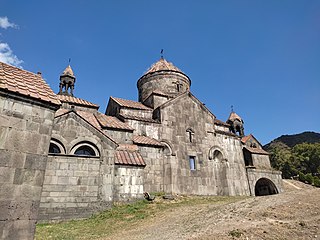
A monastery is a building or complex of buildings comprising the domestic quarters and workplaces of monastics, monks or nuns, whether living in communities or alone (hermits). A monastery generally includes a place reserved for prayer which may be a chapel, church, or temple, and may also serve as an oratory, or in the case of communities anything from a single building housing only one senior and two or three junior monks or nuns, to vast complexes and estates housing tens or hundreds. A monastery complex typically comprises a number of buildings which include a church, dormitory, cloister, refectory, library, balneary and infirmary, and outlying granges. Depending on the location, the monastic order and the occupation of its inhabitants, the complex may also include a wide range of buildings that facilitate self-sufficiency and service to the community. These may include a hospice, a school, and a range of agricultural and manufacturing buildings such as a barn, a forge, or a brewery.
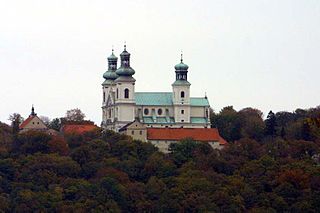
The Camaldolese Hermits of Mount Corona, commonly called Camaldolese is a monastic order of Pontifical Right for men founded by Saint Romuald. Its name is derived from the Holy Hermitage of Camaldoli, high in the mountains of central Italy, near the city of Arezzo. Its members add the nominal letters E.C.M.C. after their names to indicate their membership in the congregation. Apart from the Roman Catholic monasteries, in recent times ecumenical Christian hermitages with a Camaldolese spirituality have arisen as well.

Benedictine College is a private Benedictine liberal arts college in Atchison, Kansas, United States. It was established in 1971 by the merger of St. Benedict's College for men and Mount St. Scholastica College for women. It is located on bluffs overlooking the Missouri River, northwest of Kansas City, Missouri. Benedictine is one of a number of U.S. Benedictine colleges and is sponsored by St. Benedict's Abbey and Mount St. Scholastica Monastery. The abbey has a current population of 53 monks, while the Mount monastery numbers 147 community members. The college has built its core values around four "pillars" — Catholic, Benedictine, Liberal Arts, Residential — which support the Benedictine College mission to educate men and women in a community of faith and scholarship.

Christian monasticism is the devotional practice of Christians who live ascetic and typically cloistered lives that are dedicated to Christian worship. It began to develop early in the history of the Christian Church, modeled upon scriptural examples and ideals, including those in the Old Testament, but was not mandated as an institution in the scriptures. It has come to be regulated by religious rules and, in modern times, the Canon law of the respective Christian denominations that have forms of monastic living. Those living the monastic life are known by the generic terms monks (men) and nuns (women). The word monk originated from the Greek μοναχός, itself from μόνος meaning 'alone'.
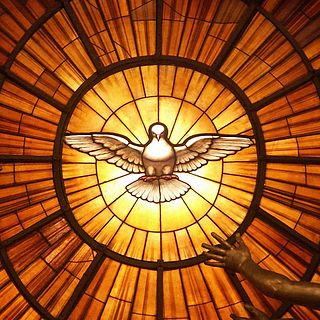
The Catholic Charismatic Renewal (CCR) is a movement within the Catholic Church that is part of the wider charismatic movement across historic Christian churches.
The Society of the Atonement, also known as the Friars and Sisters of the Atonement or Graymoor Friars and Sisters is a Franciscan religious congregation in the Catholic Church. The friars and sisters were founded in 1898 by Paul Wattson and Lurana White as a religious community in the Episcopal Church. The religious order is dedicated to the Blessed Virgin Mary under the Marian title of Our Lady of Atonement.
In Christianity, an oblate is a person who is specifically dedicated to God and to God's service.
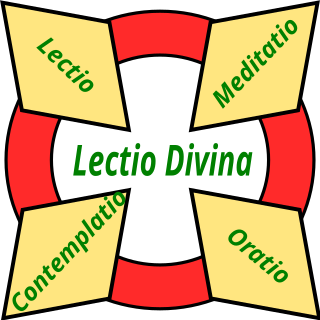
from Western Christianity, Lectio Divina is a traditional monastic practice of scriptural reading, meditation and prayer intended to promote communion with God and to increase the knowledge of God's word. In the view of one commentator, it does not treat Scripture as texts to be studied, but as the living word.

The Abbey of Our Lady, Help of Christians, commonly known as Worth Abbey, is a community of Roman Catholic monks who follow the Rule of St Benedict near Turners Hill village, in West Sussex, England. Founded in 1933, the abbey is part of the English Benedictine Congregation. As of 2020, the monastic community had 21 monks.

Holy Name Monastery is a Roman Catholic Benedictine women's monastery located in Saint Leo, Florida, owned and operated by the Benedictine Sisters of Florida. It was known first as Holy Name Convent and then as Holy Name Priory before taking its current name in the 1990s.

Anglican religious orders are communities of men or women in the Anglican Communion who live under a common rule of life. The members of religious orders take vows which often include the traditional monastic vows of poverty, chastity and obedience, or the ancient vow of stability, or sometimes a modern interpretation of some or all of these vows. Members may be laity or clergy, but most commonly include a mixture of both. They lead a common life of work and prayer, sometimes on a single site, sometimes spread over multiple locations. Though many Anglicans are members of religious orders recognized by the Anglican Communion, others may be members of ecumenical Protestant or Old Catholic religious orders while maintaining their Anglican identity and parochial membership in Anglican churches.

There are a number of Benedictine Anglican religious orders, some of them using the name Order of St. Benedict (OSB). Just like their Roman Catholic counterparts, each abbey/priory/convent is independent of each other. The vows are not made to an order, but to a local incarnation of the order, hence each individual order is free to develop its own character and charism, yet each under a common rule of life after the precepts of St. Benedict. Most of the communities include a confraternity of oblates. The order consists of a number of independent communities.
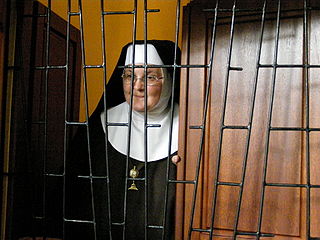
Enclosed religious orders or cloistered clergy are religious orders whose members strictly separate themselves from the affairs of the external world. In the Catholic Church, enclosure is regulated by the code of canon law, either the Latin code or the Oriental code, and also by the constitutions of the specific order. It is practised with a variety of customs according to the nature and charism of the community in question. This separation may involve physical barriers such as walls and grilles, with entry restricted for other people and certain areas exclusively permitted to the members of the convent. Outsiders may only temporarily enter this area under certain conditions. The intended purpose for such enclosure is to prevent distraction from prayer and the religious life and to keep an atmosphere of silence.

Saint Benedict's Monastery is a monastery of the Sisters of the Order of Saint Benedict, in St. Joseph, Minnesota, United States. The 17th and current Prioress of Saint Benedict's Monastery is Sister Susan Rudolph, OSB who was installed on June 4, 2017.

Sclerder Abbey is a former Carmelite monastery in Cornwall, England, UK, located between Looe and Polperro, which accommodates a Roman Catholic Community with an ecumenical vocation, which grew out of a prayer group in Lyon, France, in 1973. It currently has around 2000 members in over 30 countries.
Mother Gertrude McDermott (1846–1940) was a member of the Order of St. Benedict from 1879 until her death on September 22, 1940. McDermott began her life's work on an Indian reservation in the Dakota Territory where she was a teacher as well as a friend and adviser to Sitting Bull. She went on to be the founder of several educational and medical institutions in Sioux City, Iowa. McDermott also established a religious community which continues as the Benedictine Women of Madison in Wisconsin.
Mary David Walgenbach is an American nun. She serves as the prioress of Holy Wisdom Monastery in Middleton, Wisconsin.














